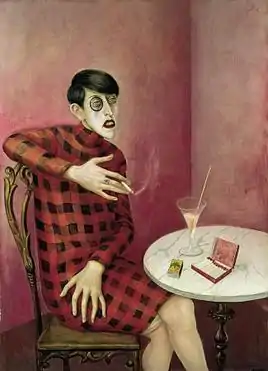Portrait of the Journalist Sylvia von Harden
The Portrait of the Journalist Sylvia von Harden (German: Bildnis der Journalistin Sylvia von Harden) is a painting by German painter Otto Dix, from 1928. The painting was made in wood with a mixed technique of oil and tempera. The painting was bought from the artist in 1961 by the Musée National d'Art Moderne in Paris.
| Portrait of the Journalist Sylvia von Harden | |
|---|---|
 | |
| Artist | Otto Dix |
| Year | 1928 |
| Medium | Mixed technique of oil and tempera on wood |
| Dimensions | 121 cm × 89 cm (48 in × 35 in) |
| Location | Musée National d'Art Moderne, Paris |
Description
On a red and pink background, without decoration and opening, which evokes the angle of a cafe, the androgynous looking woman appears sitting cross-legged in front of a round table. She is wearing a red and black plaid dress with a high collar. She holds a lit cigarette in her right hand while the left rests on the right thigh. The fingers are long with slightly protruding bones. The face is triangular with a pointed chin. A long, clean nose separates the eyes surrounded by dark circles. She wears a monocle on the right eye. Her brown hair is very short. On her pale skin stands out the slightly ajar mouth highlighted with a dark red lipstick. The woman is wearing light stockings, the rolled edge of which can be seen on the right leg.
The woman's feet are not visible, because the portrait stops at mid-calf. On the table with a white marble top are placed a cigarette box marked with the name Sylvia von Harden, a matchbox bearing the German eagle and a conical glass three-quarters full. The round shapes of the art nouveau furniture contrast with the geometric shapes of the character and the objects.
The character occupies the left half of the painting. The absence of decorative background elements accentuates her strong "presence", with nothing distracting the viewers eye. The journalist poses three-quarters and looks sideways between the plane of the painting and the perpendicular one, which links the viewer to the portrait.[1][2]
History
The subject of the portrait described his genesis in her article, "Erinnerungen an Otto Dix" ("Memories of Otto Dix"), in 1959. The painter met her on the street by chance and was impressed with her looks. He stated:
'I must paint you! I simply must!... You are representative of an entire epoch!'
'So, you want to paint my lacklustre eyes, my ornate ears, my long nose, my thin lips; you want to paint my long hands, my short legs, my big feet—things which can only scare people off and delight no-one?'
'You have brilliantly characterized yourself, and all that will lead to a portrait representative of an epoch concerned not with the outward beauty of a woman but rather with her psychological condition.'[3]
Von Harden agreed to pose for the painter, and would sit for him during several sessions in the following weeks, until the portrait was finished.
References
- Marie Gispert, «Je pensais que tu étais beaucoup plus grande. Otto Dix et Sylvia Von Harden», Les Cahiers du musée d'Art moderne, no 118, Winter 2011-2012, Centre Georges-Pompidou, Paris (French)
- Jessica Boissel, "Portrait de Sylvia Von Harden", collection of the M.N.A.M. Centre Georges Pompidou, catalogue 1987, Paris (French)
- Michalski, Sergiusz (1994). New Objectivity. Cologne: Benedikt Taschen. ISBN 3-8228-9650-0